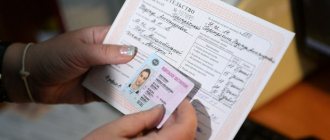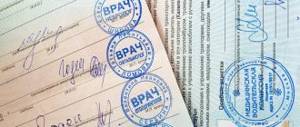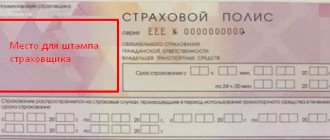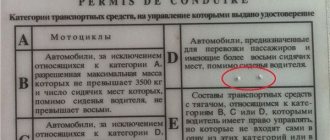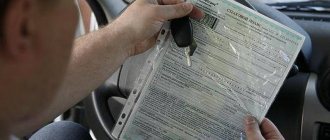03.01.2021
no comments
3374
You can often find that on the back of a driver’s license there is a GCL mark or the inscription “Glasses/lenses are required” (for old-style documents). As expected, this obliges the driver to use vision correction devices when driving a vehicle, since this has been determined by a medical examination. If this requirement is not met, the traffic police inspector has the right to draw up a report on the administrative violation and impose a large fine. Read about the legal intricacies of driving with a GCL to avoid trouble on the road.
What does the GCL mark on a driver's license mean?
Some citizens may have the inscription GCL on their vehicle driving license.
On the new type of ID cards it is located on the back side, opposite the one on which there is a photograph of the owner, at the very bottom. This is a field for special marks, the so-called fourteenth point. Next, we will consider what it means to have the GCL inscription on your license, the driver’s responsibilities, and sanctions for violation. The GCL decoding on a driver's license means glass contact lens - “glasses or contact lenses.” The inscription means that the citizen indicated in the document must use the listed vision correction devices when driving.
What is the penalty for violating the GCL label requirements?
First of all, you need to remember that you cannot drive a car without vision correction equipment if you have a medical commission’s conclusion. However, there is no direct article in the Code of Administrative Offenses that would allow inspectors to fine a driver for not having glasses or contact lenses when driving a vehicle with an active GCL tag on his license. A solution was found and inspectors began to massively issue fines under Article 12.7 of the Code of Administrative Offenses.
The traffic police are guided by part 1 of this article, which regulates the punishment for driving a car in the absence of a legal right to do so. The punishment under this article is quite harsh - from 5,000 to 15,000 rubles. The inspector actually makes a logical conclusion that if the driver does not have glasses or lenses, then this is equivalent to his not being allowed to drive the vehicle. Accordingly, there is a legal basis for applying Article 12.7.
In fact, this is not always true and even contradicts other norms of current legislation. To begin with, let’s turn to Federal Law No. 196 “On Road Safety”, where Article 28 sets out possible reasons for termination of the right to drive a vehicle:
- The current ID has expired;
- A medical examination revealed a contraindication that is incompatible with driving a vehicle;
- The driver was deprived of this right on legal grounds (for example, for driving while intoxicated).
At the same time, the list of medical contraindications is also approved by the Government of the Russian Federation (current edition No. 1604 of August 3, 2019). In this list it is impossible to find restrictions on visual acuity; accordingly, this is the basis that Article 12.7 of the Code of Administrative Offenses was applied illegally.
An interesting situation arises when the driver had medical vision limitations, but at some point in time they were cured. It often happens that a person, for example, has undergone laser vision correction. At the same time, the GCL mark on the driver’s license does not disappear anywhere, and the traffic police inspector can still apply Article 12.7 of the Code of Administrative Offenses.
Here is an example of such a case - a court decision from Cherepovets (January 2014). The driver underwent laser vision correction and was stopped by a traffic police inspector. The latter, despite presenting a certificate from the clinic, fined the person 6,000 rubles. The court recognizes that the driver violated only the fact that he did not replace his driver’s license; accordingly, the punishment imposed on him was unlawful.
Attention! If the state of vision has improved so much that it has become possible to drive a car without glasses or lenses, you must undergo a second medical examination and obtain a driving license without the GCL mark.
When and to whom the GCL mark is put on the license
The registration and issuance of a temporary residence permit for the first time or when replacing it upon expiration of its validity period is preceded by a medical examination. In addition to other health indicators, vision must be checked. During testing, you need to read the rows of a special table from a certain distance. The test results are recorded in a medical certificate of the established form. If visual acuity is below standard, the need to use glasses or lenses is noted.
This is the basis for affixing the letters GCL to the license.
Note. These marks are not placed on the license to drive special equipment, for example, a tractor driver.
Where is the mark on the new model of the driver's license?
The front and back sides of the ID are divided into fields. Each of them contains certain information about their owner:
- Surname
- First and middle name
- Date and place of birth
- Validity period of the license, etc.
There are a total of 9 fields on the front side. The last of these is the permitted categories of driving vehicles. The fields are numbered, numbers are in front of each inscription.
On the reverse side there is a table indicating vehicle categories and opening dates (10), expiration dates (11) and control restrictions (12).
Column 13 is occupied by a barcode.
Below the table is a number. This is column 14 in the driver’s license, reserved for special marks. It contains the Latin letters GCL, indicating vision problems and a requirement to wear glasses or lenses when driving a car or motorcycle.
About (GCL)
Regarding the new rights that are issued according to international standards, they have a completely different mark. At the same time, the meaning of this mark is similar. But it is called “GCL”. This abbreviation literally stands for glasses or contact lenses. From English this translates as glasses or contact lenses. This mark also indicates that the subject has some visual impairment and should operate the vehicle with glasses or contacts only.
Both marks are similar in essence and can be used in both national and international licenses.
What other marks are put according to medical restrictions?
In addition to visual impairments, drivers may have other health problems that result in restrictions on driving. There are special designations for them, indicated in paragraph 14 of the military license:
- MC (Manual Control Only) The car must be equipped with a system that allows you to drive it with your hands without using your feet.
- AT (Automatic Transmission) – the driver can only drive vehicles with an automatic transmission
- APS (acoustic parking system only - only automatic parking system)
- HA/CF (must wear hearing aid/communication aid) – a hearing aid is required when driving.
These are the most common designations. Sometimes people ask what ML means in rights. This is a direct prohibition of driving category M vehicles such as scooters, mopeds, etc. Or AS - permission to drive vehicles with a traditional steering wheel.
In addition to medical indications, paragraph 14 of the license may indicate the date of receipt of the driver's license. This is usually written by novice drivers.
Is it possible to eliminate a mark?
To obtain a license, it is necessary to present a medical certificate. There are several options when this can be done without it. In this case, the same marks will be added to the new document, including the fourteenth paragraph with GCL, that were in the old one. Therefore, to get rid of them, you need to show the ophthalmologist during a medical examination that your vision does not require correction.
Attention! The medical examination must be completed in an organization that has the appropriate license. Otherwise, the certificate will not have legal force, and it will not be possible to remove the mention of mandatory glasses or lenses. Time and money will be wasted.
With a certificate, you should contact the authorized organization REO of the State Traffic Safety Inspectorate, MFC, etc. and obtain new rights to replace the old ones without unwanted letters in special marks.
What to do if the driver has had vision correction surgery
Legally, the question of whether it is mandatory to wear glasses or contact lenses while driving a vehicle arises when documents are checked by a traffic police inspector. He cannot, is not obliged and does not have the authority to check the compliance of vision with standard indicators. In this matter, the only guide to action for him is the information from the document.
If, as a result of surgical treatment, a citizen’s vision is restored to a normal level that does not require correction, but the license remains old with the GCL mark, the inspector has the right to require the wearing of glasses. In their absence, he has the right to apply sanctions provided for by law.
To avoid such a situation, the driver must visit a licensed medical institution, undergo a medical examination, and obtain a certificate confirming normal vision. Contact the MFC, REO of the State Traffic Safety Inspectorate with it and replace the existing rights with new ones that do not contain a note in column 14.
Only after this will it be possible to drive without glasses or contact lenses.
Is it necessary to use glasses/lenses if vision is poor, but there is no note on your license?
As explained earlier, for persons controlling traffic, the legal obligation to wear glasses or lenses exists if there is a special mark on the license. Without it, even with poor vision, it is impossible to force the driver to wear glasses.
Keep in mind: the use of corrective agents is primarily necessary to ensure safe driving.
With reduced vision, you may not notice a road sign, be unable to read a warning sign, or be unable to distinguish a cyclist or pedestrian. All cases are fraught with a traffic accident with serious consequences. When examined by the traffic police or in court, visual impairment will be identified, and it is possible that the blame for the consequences will be placed on the driver. The basis for this may be clause 2.7 of the traffic rules, which prohibits driving while sick. This concept is not specified by the rules, but under certain circumstances it can be classified as reduced vision.
Conclusion. There is no need to risk your own health, property, and in the worst case, freedom and life. You should consult a doctor and put on glasses or contacts yourself, without waiting for the mandatory mark on your license to appear.
An exception can be made when visual acuity is about 0.9. At the same time, during the day everything is visible quite well, but with the onset of twilight it is worse.
Marking points on your license: what is it and what does it oblige you to?
Current legislation does not in any way restrict drivers who even have health problems. In order not to infringe on the rights of people with poor vision, the ability of such subjects to drive a vehicle is provided. Logically, if they can perform other types of work wearing glasses or lenses, then why can’t they drive?
But the presence of vision problems obliges the subject to drive with special equipment - glasses or contacts.
And there is even a special note about this on the driver’s license. The note may have the following wording: “Glasses/lenses are required.” This means that the driver has a medical obligation to wear glasses or contact lenses while driving a vehicle. If he does not want or cannot for some reason put on glasses, then he cannot sit behind the wheel. It's simple. Interesting information : such a note as “Glasses-lenses are required” exists on driver’s licenses that were issued before 2011. Consequently, the maximum period for their circulation is until 2021. We remember that the document has a validity period of 10 years. After this period it must be replaced.
What are the penalties for violating marks?
There is no direct punishment in the Administrative Code for the absence of glasses or lenses, which are prescribed to be worn in column 14 of the driver’s license. However, if an inspection reveals a discrepancy, sanctions will not be avoided. In accordance with the explanations of the head of the Russian State Traffic Safety Inspectorate, the absence of glasses is equivalent to driving without a license. The same position is adhered to in court.
A discrepancy between the last name, first name, patronymic, and date of birth makes the driver’s license invalid. Driving a vehicle without a permit mark in the category column is also considered driving without a license. The absence of points in the presence of GCL letters in paragraph 14 is assessed in the same way.
According to paragraph 12.7 of the Code of Administrative Offenses, driving a vehicle without a license or without mandatory glasses is punishable by a fine of 5,000...15,000 rubles. In this case, the offender may be removed from driving, and the car or motorcycle may be sent to the impound lot.
Considering the interest of automobile inspection employees in identifying violations and carefully hidden plans for the number of protocols, it is better not to take risks and wear glasses or contacts.
What is the penalty for driving with a license with a GCL mark without glasses or lenses?
Driving by drivers who have indications for driving a vehicle only with glasses or lenses, without these medical devices, is often equated by inspectors to driving without a license (Article 12.7 of the Code of Administrative Offenses of the Russian Federation.) This violation provides for a fine of 5 to 15 thousand rubles.
At the same time, drivers whose license contains the GCL mark can independently choose what to drive in: glasses or contact lenses. While an inspector can notice and record the absence of glasses (video recording, witness testimony), it is impossible to check the driver’s absence of lenses. The employee does not have the right to demand that the driver remove and show him the lenses, as this may harm the person’s health.
Is it necessary to prove to a traffic police officer the presence of lenses?
Every duty implies the possibility of verifying its fulfillment. The necessity contained in the fourteenth paragraph of the VU is no exception. In this case, there is a note in the license about glasses, obliging the use of vision correction devices. The presence of glasses is visible and beyond doubt. An ophthalmologist can recognize the lenses. By the way, there is no need to try to undergo a medical examination in them and do not put an unwanted mark on the Permis de conduire - this is how the name of the old-style document was duplicated. The cunning man will be exposed, the lenses will be forced to be removed, and the real state of affairs will be revealed. The traffic police inspector most likely does not possess such skills; claims can be expected from him regarding violation of the requirements of paragraph 14.
Important! No legal norms stipulate the obligation of citizens to prove the presence of lenses on the road. You can simply say that he has them. In the event of a conflict, it is necessary to write about it in the protocol, and the court will support its correctness.
In order not to take the situation to the extreme, it is recommended to stock up on some document confirming the presence of lenses, at least a receipt for their payment, and carry the original or a copy with you. The traffic inspector knows the laws, that will be enough.
conclusions
- The GCL mark on your license indicates visual impairment. If it is present, the vehicle must be driven with glasses or contact lenses.
- In order to issue a license without this mark, confirmation of visual acuity compliance with the standards is required. When replacing in a new device, this inscription will be omitted.
- After corrective surgery, you must undergo a medical examination. If the outcome is favorable, a medical certificate will be issued allowing you to drive without glasses. On its basis, the rights will be replaced with “clean” ones.
- If you have poor eyesight and do not have a note on your license, you can legally drive without glasses. It is recommended not to abuse this for traffic safety.
- For driving without glasses or lenses with the GCL mark, the violator is fined 5,000...15,000 rubles and the car is detained and placed in an impound lot.
- The driver is not required to prove that he is wearing contact lenses. To avoid conflict situations, it is recommended to keep with you any document confirming their availability.
What are the consequences of violating the requirements?
It is logical to assume that the driver faces punishment for violating the restrictions. However, not everything is so simple. Sanctions for violating traffic rules are prescribed in the Code of Administrative Offences. Driving a vehicle without glasses and lenses is not identified as a separate offense.
Therefore, in practice, violators are subject to the requirements of Article 12.7, which provides for punishment for driving a vehicle by a driver who does not have such a right. The fine for driving without glasses or lenses in accordance with Article 12.7 ranges from 5 to 15 thousand rubles.
